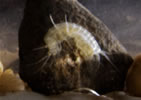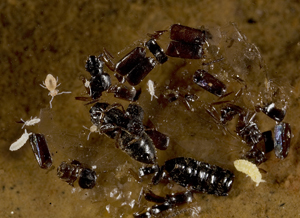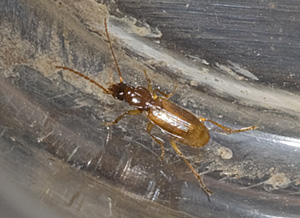Insects belong to the Class Insecta in the Phylum Arthropoda. There are many cave species in this group including some that are possibly troglobitic in Britain.
COLLEMBOLA (SPRINGTAILS)
The springtails are an ancient group of arthropods, similar forms have been found as fossils that are around 400 million years old. They are wingless ground dwelling insects that require high humidity. Many species have been recorded from the caves of the Mendip Hills. They are called springtails due to their ability to leap about with the aid of a trigger or ‘spring’. Soil and underground species appear to have evolved a smaller spring, shorter legs and antennae, reduction in eyes and loss of pigment. They feed on fungal mycelia, bacteria, decomposing plant and animal material. Not all springtails seem to jump - some walk about on the surface as if they are grazing.
Springtails are most easily found on the surface of pools, some are so small (1mm) they will look like specks of white dust to begin with, but if you observe them for perhaps a minute one might leap a couple of inches – enough to convince you that it is actually alive. They are so light and small they can move about on top of the surface film of the water. Best places to look are still pools and damp mud banks.
Oligaphorura (=Onychiurus) schoetti (recorded from GB Cavern, Pen Park Hole, and St. Cuthbert’s Swallet) and Onychiurus dunarius (Read’s Cavern and Swildon’s Hole) have not been recorded outside caves and mines in Britain and are thought to be possible troglobites within the country.
|
Various species of springtail around carcass of rove beetle in Withyhill cave.
|
THYSANURA (THREE TAILED BRISTLETAILS)
Three tailed Bristletails might occasionally turn up in the soil and leaf litter in the threshold zone of caves. They are small insects covered with scales and have three tails (cerci) on their rear. They include the silverfish sometimes found in sheds and houses. They may be found in the winter months in the thresholds of the drier caves. This is Dilta spp. in Loxton Quarry Cave.
DIPLURA (TWO TAILED BRISTLETAILS)
Two tailed bristletails are primitive eyeless insects with segmented antennae that generally live underground in soil and leaf litter. They resemble white earwigs and live on prey and dead organic matter including springtails and fungi. This photograph of a Diplura is from Singing River Mine. It has lost one of the tails but Diplura are unusual in that they are able to regenerate lost body parts. On some species the tails (cerci) are used as pincers.
DIPTERA (TWO WINGED FLIES)
Many species of Diptera are found in caves but most are visitors. The flies are often found in the same place year after year. The hind wings of Diptera are modified into a pair of balancing organs called halteres.
Craneflies visit the threshold in summer, they do not feed as adults. The crane fly Limonia nubeculosa is often found in cave thresholds as a summer visitor – it rests with its speckled brown wings covering its abdomen unlike many crane flies. Outside it is found all year round. There are often many in the threshold of caves and it has been recorded from Goatchurch Cavern, Quaking House Cave and Sandford Levy.
Dungflies e.g. Leria (=Heleomyza) serrata visit the threshold. They arrive in autumn and remain until starvation or fungal attack. Maybe they settle somewhere dry in the dark zone in winter and get caught out as air current reverses in summer with the corresponding rise in humidity and condensation. This dampness is ideal for the fungi to attack them. Adults are found all year round in the cave, but the reason why is not clear.
|
Hibernating Dungfly in Aveline's Hole |
Fungus gnats (Mycetophilidae) such as Speolepta leptogaster are numerous in caves, some consider this species a troglobite as the larvae has not been found outside of cave-like habitats. The adult looks like a olive-brown miniature crane fly with long legs. The yellow headed translucent larvae (14mm) live in a web of thin threads (looks a bit like a sheet spiders web), and probably live on bacteria and fungi. The tangled mass of threads is to keep the insect from touching the walls, becoming wet and then falling prey to fungi. They can be seen along the walls of Goatchurch Cavern, Gough’s Cave, Lamb Leer Cavern and Quaking House Cave
Sciara gnats (also known as black fungus midges) are similar to fungus gnats but the 12 segmented larva has a black head, white semi-translucent body and does not spin a web. Sciarids feed on decaying plant and animal material
The winter gnat Trichocera maculipennis can be found quite deep underground in large cave systems and has been recorded from Eastwater Cavern and Lamb Leer Cavern. The adult is widely distributed but rarely seen, the larvae are attracted to baits such as rotting meat.
The common mosquito (Culex pipiens) - inseminated females overwinter in cave thresholds and then leave the cave in spring for a blood meal, usually from a bird (not from humans). There are several generations a year.
|
Culex pipiens (female) in Gough's Cave. |
Blackfly (Simulium sp.) larvae, like these in GB Cave, are washed in by accident. They can be seen anchored to the rocks in the fast flowing stream trying to catch debris as it floats past.
A variety of other fly species have been recorded from Mendip caves, including species in the families Psychodidae, Chironomidae, Phoridae, Sphaeroceridae and Calliphoridae.
MAYFLY, STONEFLY, CADDIS FLY
These generally have two pairs of wings although the hind pair is sometimes much reduced in size or missing as in some mayfly. Mayflies (Ephemeroptera), stoneflies (Plecoptera) and caddis flies (Trichoptera) have nymphs that live in streams and rivers for a few years before becoming an adult fly that may only live for a few days. Their nymphs are washed into caves from the surface and a variety of species can be found in the streams of the Mendip caves, sometimes a considerable way underground. Nymphs of the stoneflies Nemoura erratica and Isoperla grammatica, the mayfly Baetis rhodani and the net-spinning caddis larvae Plectrocnemia spp. have been found as far underground as Sump 9 in Swildon’s. The silk net galleries of Plectrocnemia spp. caddis larvae can be seen beneath waterfalls in the GB Cavern streamway and inlets of Swildon's Hole. If a sufficient food supply is washed in by the stream these nymphs and larvae can continue to survive underground but as soon as they metamorphose into winged adults they will die as the adult stages often rely on plants for feeding.
Adults of the large buff coloured caddisfly Stenophylax permistus use the cave threshold as a resting stage for part of the summer – they have been recorded from Lamb Leer Cavern and Sandford Levy but undoubtedly occur in the threshold of other caves.
HEMIPTERA (BUGS)
Two species of Aquatic Bug have also been recorded from cave streams and as with the nymphs described above have been washed in from the surface. The Water Cricket (Velia caprai) has been recorded from St. Cuthbert’s Swallet and the Water Scorpion (Nepa cinerea) is known from Swildon’s Hole.
LEPIDOPTERATA (BUTTERFLIES AND MOTHS)
Two species of moth commonly overwinter in the thresholds of Mendip caves (they do move around the cave during this time). The Herald moth (Scoliopteryx libatrix) is common in many dry cave entrances (e.g. Goatchurch Cavern, Sandford Levy) and is often found in the dark zone beaded in moisture, staying up to 10 months underground – it is unlikely this is all hibernation so why does it spend all this time in the cave? It may be for the ovaries to develop. It keeps its head pointing away from the light. The caterpillar eats willow and poplar. The Tissue moth (Triphosa dubitata) settles closer to the entrance and lower down the wall than the Herald moth. The caterpillar eats buckthorn and blackthorn. Triphosa has been recorded from Biddlecombe Rift Cave, Browne’s Hole, Lamb Leer and Sandford Levy but is present at other sites.
|
Herald and Tissue moths in Gough's Cave |
COLEOPTERA (BEETLES)
Many species of beetle are cavernicoles. A variety of species can potentially be found in the threshold of caves but the ones most likely to be found deeper underground are members of the ground beetle (Carabidae) and rove beetle (Staphylinidae) families. In the Mendips the ground beetle Trechoblemus micros is one of the most common terrestrial beetles found underground (recorded from Blake’s Farm Cave, Hillier’s Cave, Pen Park Hole, W/ L Cave and Stoke Lane Slocker), along with the rove beetles Quedius mesomelinu, Ancyrophorus aureus (both recorded from a variety of caves, wet and dry) and Lesteva pubescens (Eastwater cavern, Goatchurch Cavern and Swildon’s Hole). These three species are generally regarded as troglophilic. Other beetle species found in the threshold include members of the families Silphidae, Cantharidae, Dermestidae, Cryptophagidae and Leptinidae.
Aquatic beetles have also been recorded from wet caves, washed in from the surface, including: Haliplus lineatocollis, Hydraena gracilis, Helophorus brevipalpis, Megasternum obscurum, Anacaena globulus, Helodes minuta, Hydroporus discretus, Ilybius fuliginosus, Agabus conspersus and Agabus guttatus. These species can all be found in streams and pools on the surface. The diving beetle Agabus guttatus (recorded from Eastwater Cavern and Manor Farm Swallet) is recorded from caves across the country and seems to be able to survive well underground. In Manor Farm Swallet it has been found living in a tiny trickle of water on a vertical face near the climb up into NAHSA Gallery. On the surface it is usually associated with springs and spring-fed pools.
|
Trechoblemus micros in Swan Mine |
OTHER INSECTS
Fleas are common on bats. They are small wingless parasites noted for their ability to leap.
|



.jpg)
.jpg)
.jpg)
